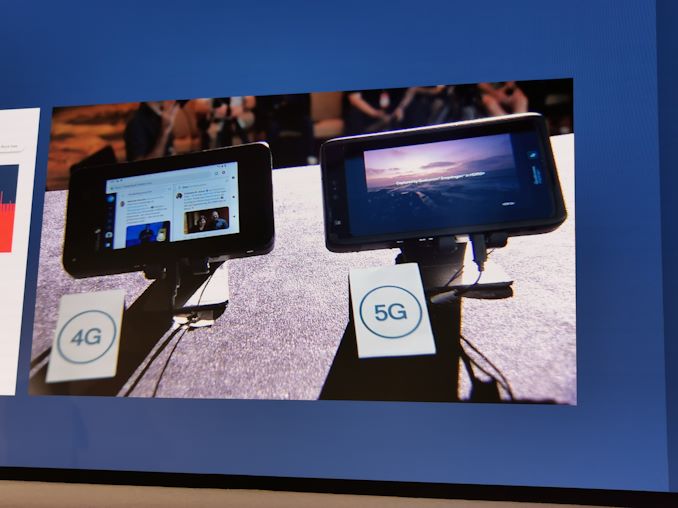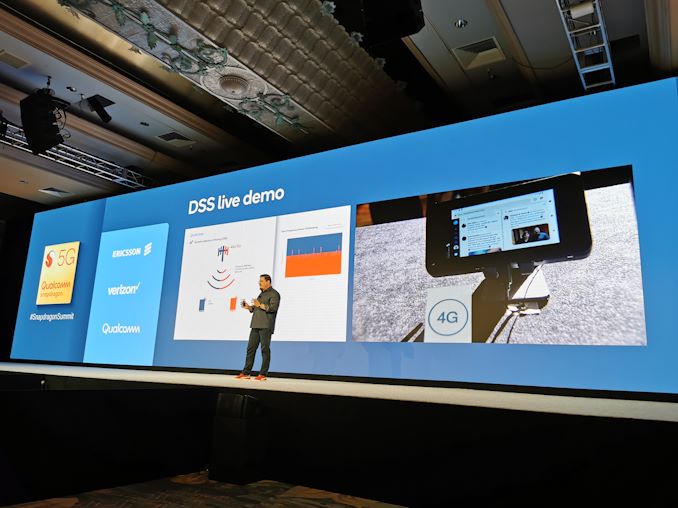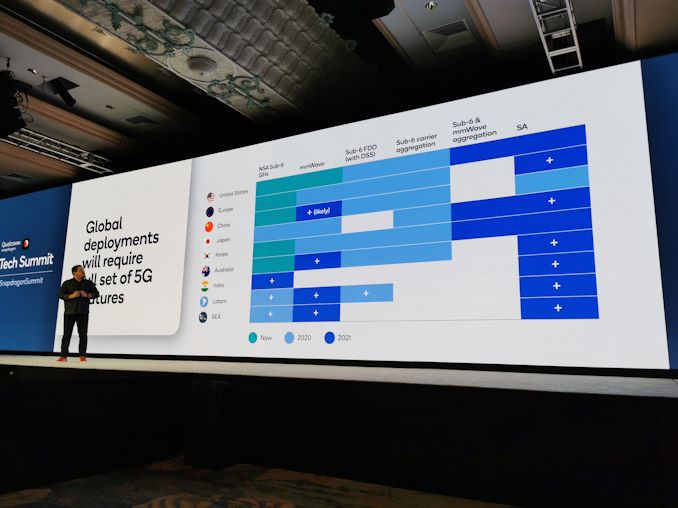Quick Bytes: Qualcomm’s Dynamic Spectrum Sharing Demo with 5G and 4G
by Dr. Ian Cutress on December 4, 2019 9:00 AM EST- Posted in
- Smartphones
- Qualcomm
- 4G
- 5G
- Qualcomm Summit 2019
- DSS

One of the key elements of any new wireless coverage standard is how to carve up the frequency spectrum. We’ve covered in previous articles that 5G will operate in different frequency ranges in different countries, due to different regulations, but one of the other key areas to discuss is where the intended frequency ranges for 5G overlap with spectrum already allocated for the 4G market. When this sort of thing has occurred with new wireless technologies, each part of the spectrum was ringfenced for obvious reasons. However Qualcomm is looking to solve some of those teething issues by enabling Dynamic Spectrum Sharing across a number (if not all) of its 5G modems being launched in 2020.
When the spectrum has to be carved and ringfenced, this typically requires adjustment of the antenna sites. With Dynamic Spectrum Sharing, the 4G deployment can stay as is, with the 5G hardware being installed at the same site, with the device being able to manage which standard it connects to. As 5G implements a number of things to help increase bandwidth, ease congestion, and help improve latency, then obviously if you have access to a 5G device and a 5G access point, you want to stay in 5G mode for as long as is physically possible.
The demo that Qualcomm showed as part of its annual Snapdragon Tech Summit involved its new chipset reference devices, one based on 4G and the other on 865 or 765, with DSS enabled. Both devices were connected to a 4G/5G access point transmitting at 850 MHz (n5), using 10 MHz bandwidth.
The time/frequency division graph showed a near 50/50 split between 4G and 5G as the 10 MHz bandwidth appears to be separated, but both devices are using the n5 band.
Qualcomm expects DSS support, with Sub 6 GHz bands (not mmWave), in several key countries in 2020 (USA, EU, China, Korea, Australia). For chipset support, the new Snapdragon 865 paired with the X55 modem or the 765/765G chipsets with their internal X52 modems will both have DSS support as long as it also gets enabled at the OEM/device level. Motorola, Oppo, Xiaomi, and HMD Global (Nokia) were all part of today’s announcement about having future devices built on the new Snapdragon chipsets, so I can imagine that they should all also be supporting DSS through the Qualcomm solution.
As Qualcomm’s Snapdragon Tech Summit continues for the next couple of days, I imagine we might see more DSS demos when the hardware demo area opens tomorrow. Stay tuned.
Quick Bytes are shortened news pieces about topics mentioned at large press events. Because sometimes smaller announcements get buried at a keynote presentation because a dozen key points are mentioned in one article, and our Quick Bytes series separates out a few topics for targeted discussion.












1 Comments
View All Comments
name99 - Thursday, December 5, 2019 - link
What am I looking at here?Is this supposed to be a client side technology or a server side technology? And what's the big deal? I mean, sure, maybe for telcos it's something new to run multiple protocols on the same spectrum, but WiFi has been that way since forever.
I don't mean to be cynical but how this is not Qualcomm saying "look, we implemented a not very difficult part of the spec [just like every other 5G vendor], and it works! Give us a treat!" ?